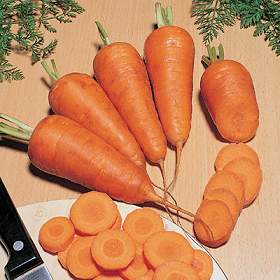Description
Cosmic Purple Carrot
250 Seeds per pack
Days to Maturity: 60–80 Days
Sun Requirements: Full sun; tolerates partial shade.
Botanical Name: Daucus carota
A stunning addition to any garden or plate, Cosmic Purple carrots are as flavorful as they are colorful. Bred by Dr. Philipp Simon and his team at the USDA in Madison, Wisconsin, this heirloom variety was released in 2005, when colorful carrots were starting to become popular again.
These tapered, Danvers-type roots grow 6 to 8 inches long, featuring vibrant purple skin with a bright orange or yellow core. The taste is sweet, slightly earthy, and mildly spicy—some even describe it as peppery. This unique flavor profile makes them equally suited for raw snacking, roasting, juicing, or baking into carrot cake. Plants are robust, reaching around 15 inches tall under ideal conditions, and exhibit resistance to some common garden pests and diseases, making them a great low-maintenance option for both home gardeners and market growers.
Enjoy them fresh in salads or slaws, glazed or roasted as a side dish, or even fermented for a colorful twist on pickled veggies. Rich in anthocyanins and antioxidants, these carrots are a healthy addition to the kitchen.
Whether you’re looking to impress at the dinner table or grow something unique, Cosmic Purple delivers beauty and flavor in every bite!
Planting Instructions for Cosmic Purple Carrot Seeds
When to Plant:
Direct sow Cosmic Purple carrot seeds outdoors 2 to 3 weeks before your last expected spring frost, once the soil reaches at least 50°F (10°C). Cosmic Purple grows best in cooler temperatures and can be planted again in late summer—about 10 weeks before your first fall frost—for a sweeter, fall-harvested crop. For staggered harvests, continue sowing small batches every 3 to 4 weeks during the main season. Avoid transplanting, as disturbed roots can grow misshapen.
Where to Plant:
Choose a site in full sun with light, loose, stone-free soil. Cosmic Purple thrives in well-drained, fertile soil and benefits from a deeply prepared seedbed. Raised beds or containers work well but aren’t required in most soils. Avoid beds that were recently amended with fresh manure, which can cause forking. A soil pH of 6.0 to 6.8 is ideal. Before planting, loosen the soil at least 12 inches deep and mix in well-aged compost.
How to Sow:
Sow Cosmic Purple seeds ¼” deep and 1″ apart in rows spaced 12 to 18 inches apart. The seeds are tiny—try mixing them with sand to distribute them more evenly. Cover with ⅛” to ¼” of sifted compost or fine soil, not coarse dirt. Press down gently and keep the surface moist. For best results, cover rows with burlap or shade cloth until the seeds sprout. Germination may take 7 to 21 days depending on soil temperature and moisture.
Watering:
Cosmic Purple seeds need consistent moisture to germinate properly. Use a fine mist spray or a micro-spray system to avoid displacing seeds. Once established, water about 1 inch per week. When carrots begin to size up, increase watering to 2 inches per week to encourage root development. Avoid inconsistent watering, which can cause roots to split. Always water at the soil level—avoid overhead sprinklers that may promote disease.
Fertilization:
Before sowing, mix in 2–3 inches of compost or well-rotted organic matter. Avoid nitrogen-rich fertilizers, which encourage leafy growth at the expense of root development. Once tops are about 4 inches tall, side-dress with a balanced organic fertilizer or compost tea. Avoid adding extra phosphorus unless your soil is deficient, as it may lead to split or misshapen roots.
Mulching:
Once seedlings are 1–2 inches tall, add a layer of mulch to retain moisture, suppress weeds, and keep soil temperatures consistent. Use straw, shredded leaves, or dried grass clippings. Avoid using fresh clippings, which release too much nitrogen too quickly and can lead to forked roots. Let clippings dry for a few days before applying in a thin layer. Mulch also helps keep carrot shoulders from turning green from sun exposure. In early spring, black plastic mulch can warm the soil and speed up germination.
Thinning:
Thin Cosmic Purple seedlings when they are 1–2 inches tall to about 2–3 inches apart. Use scissors to snip the tops at soil level rather than pulling, which can disturb nearby roots. For baby carrots, thin to 1 inch apart and harvest small roots early. Proper spacing allows Cosmic Purple to grow straight and reach full size.
Pest & Disease Management:
Cosmic Purple is vulnerable to the same pests as other carrots, including carrot rust fly, weevils, nematodes, and leafhoppers. To prevent damage, use floating row covers from planting until harvest, and avoid disturbing the foliage when weeding, as its scent can attract pests. Rotate crops yearly, and don’t plant carrots in the same area more than once every three years. Keep the bed free of weeds and debris. For nematodes, avoid planting in infected soil and consider interplanting with French marigolds.
Common Diseases:
This variety may be affected by powdery mildew, leaf blights, and root canker. Ensure good air flow by thinning and avoiding overcrowding. Water early in the day and avoid wetting the foliage. Remove any infected plants immediately to prevent spread.
Harvesting:
Cosmic Purple is typically ready to harvest 60 to 80 days after planting. Begin pulling when roots are 6 to 8 inches long. These colorful, Danvers-type carrots feature deep purple skin and an orange or yellow core. Loosen soil with a fork before pulling to avoid breakage. Trim tops to ½–1 inch after harvest.
Storage:
Store freshly harvested Cosmic Purple carrots in the refrigerator for up to two weeks. For longer storage, leave them in the ground under mulch and harvest as needed, provided your soil doesn’t freeze. Alternatively, store in damp sand or sawdust in a root cellar. Cosmic Purple also preserves well by freezing, canning, or dehydrating.
Freezing:
Wash, peel, and cut Cosmic Purple carrots into slices, coins, or diced pieces. Blanch in boiling water for 2 minutes (or 5 minutes for whole carrots), then transfer immediately to an ice bath. Once cooled, drain thoroughly and spread in a single layer on a parchment-lined baking sheet. Freeze until firm, then pack into freezer bags or containers. Label and store in the freezer for up to 12 months.
Canning:
Use a pressure canner. Wash, peel, and cut Cosmic Purple into slices or diced pieces. Raw pack or hot pack (simmer 5 minutes). Fill clean jars with carrots and boiling water, leaving 1 inch headspace. Optional: add 1 tsp canning salt per quart. Remove air bubbles, wipe rims, and seal. Process in a pressure canner based on your altitude. Cool completely and check seals after 24 hours.
Dehydrating:
Wash, trim, and peel if desired. Slice or dice carrots, blanch for 2 minutes, and cool in ice water. Drain and arrange in a single layer on dehydrator trays. Dry at 125°F (52°C) for 4–12 hours, until brittle or leathery. Let cool fully before storing in airtight containers in a cool, dark, dry place.
Seed Saving:
Cosmic Purple is a biennial variety. Leave healthy carrots in the ground or replant them to overwinter. In year two, they’ll flower and produce seed. Isolate by at least ½ mile from other carrot types or use row covers to prevent cross-pollination. Collect and store dried seed in a cool, dry place. Properly saved Cosmic Purple seeds remain viable for 2–4 years. We offer pre-labeled seed-saving envelopes to help you stay organized.
FAQ:
How long does it take Cosmic Purple carrots to mature?
Cosmic Purple carrots typically mature in 60 to 80 days. For baby carrots, you can start harvesting earlier, around 45–50 days, depending on your preferred root size.
When is the best time to plant Cosmic Purple carrot seeds?
Sow seeds 2–3 weeks before your last expected spring frost, once soil temperatures reach at least 50°F. You can also plant them 10 weeks before your first fall frost for a sweeter fall crop.
Can I grow Cosmic Purple carrots in containers?
Yes! Cosmic Purple carrots grow very well in containers, as long as the setup is right. Choose a pot or planter that’s at least 12 inches deep and 18 inches wide, with good drainage holes at the bottom. Use light, loose, stone-free soil—raised beds, grow bags, or wide pots all work well. Avoid shallow containers, which can cause the roots to become stunted or misshapen.
Do Cosmic Purple carrots need full sun?
They grow best in full sun (6–8 hours per day), but will also tolerate partial shade, especially in hot climates.
What do Cosmic Purple carrots taste like?
The flavor is sweet, slightly earthy, and mildly spicy, with a unique peppery note. They're excellent raw, roasted, or even pickled.
How should I water Cosmic Purple carrots?
Keep soil evenly moist, especially during germination. Water about 1 inch per week while young, increasing to 2 inches as roots develop. Avoid overwatering, which can cause cracking.
Are these carrots good for long-term storage?
Yes! Cosmic Purple carrots store well in the fridge, in a root cellar, or left in the ground and covered with mulch in mild temperatures. Just be sure the soil doesn’t freeze. You can also freeze, can, or dehydrate them for long-term use.
Can I save seeds from Cosmic Purple carrots?
Yes, but Cosmic Purple is a biennial, so you’ll need to overwinter the plants and allow them to flower in their second year. Isolate from other carrot varieties to prevent cross-pollination.
Are Cosmic Purple carrots resistant to pests and disease?
They’re considered relatively low-maintenance, with some natural resistance to common pests and diseases.

















Bobby & Rita Duty (verified owner) –
All perfect as always!
Anonymous (verified owner) –
good service and good quality
Sarah C. (verified owner) –
Everything I ordered came in the timely manner and packing was great!
Diane G. (verified owner) –
5 star!
Barbara S. (verified owner) –
Angela V. (verified owner) –